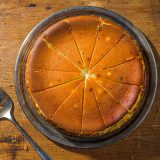Angie Mar is a troublemaker. At the Beatrice Inn, the more than century-old New York City eatery she purchased from Graydon Carter in 2016, she ages a tomahawk rib-eye for 160 days using French single-malt whiskey, then charges up to $16 an ounce, serving it with lobster butter and Périgord truffles.
But her family story does not include supping on expensive steak. In the early 1920s, her grandfather came to America to work on the railroad and her family suffered extreme poverty during the Great Depression, begging for food at the back door of Chinatown restaurants and fishing for dinner. They learned to help each other out; her father washed dishes with Bruce Lee at Ruby Chow’s, the famous Chinese restaurant founded by Mar’s aunt in Seattle in 1948. Her childhood dinner table was East meets West. Mar says, “My mother is from Taipei but grew up part of the time in Oxford, England, so between her and my Chinese-American father, our dinner table was a mixed bag... one night we would have... chicken hearts with black bean sauce, and the next it would be shepherd’s pie.”
In a review of Beatrice Inn, Pete Wells of The New York Times wrote, “Ms. Mar cooks animals, of course, but she also cooks for animals. She cooks for the animals that we are.” And her approach to running a restaurant is also unflinching. She describes it as “a combination of empire building, the military, parenting, politics, imagination, self-reflection, artistry, world domination and working harder than you ever thought possible.”
One would expect, therefore, that any recipe for cheesecake from Mar would not be humdrum. Mar views cooking like music: a symphony of taste notes that harmonize, but also provide counterpoint and surprises along the way. She throws in chèvre along with cream cheese, and adds crème fraîche (which lightens the texture). “All these flavors contrasting and pushing and pulling, but harmonizing, creating something very new off of simple and elegant. It’s like [an epiphany] because it looks so classic,” she says.
Back at Milk Street, the ingredients were less of an issue than the baking temperature and method. We were having three problems: The top of the cake was not getting sufficiently browned, it often sank as it cooled, and it cracked.
After more than a dozen cakes and a lot of research, we finally arrived at an unusual method we discovered on the website for Thermapen (a brand of instant thermometer): Bake the cake at 450°F for 20 minutes, shut off the oven, prop open the door for 10 minutes, then finish baking at 250°F, no water bath required. And, contrary to a lot of kitchen wisdom, remove the cake from the oven when the center reaches 145°F to 150°F—145°F is lower than what most recipes tell you, but it will prevent cracking.
Every baker will tell you they have the best cheesecake recipe. And others will point out “chacun à son goût”—everyone to their taste—but this cheesecake is different, hardly a one-note wonder like most of its kind. It delivers an emotional punch, a sensory surprise with the tang of chèvre and crème fraîche against a more everyday background.
And that sums up Mar’s cooking. As she says, “There’s cooking that makes you think and there’s also cooking that really makes you feel... I want it to take you back to those primal instincts where it’s just me and fire.” And so, a primal cheesecake for the ages.




